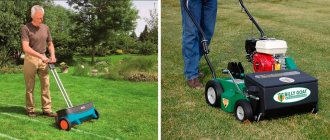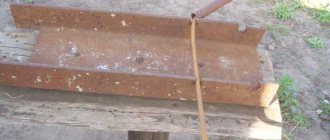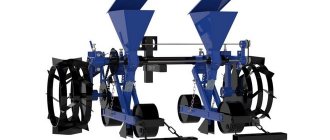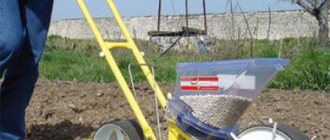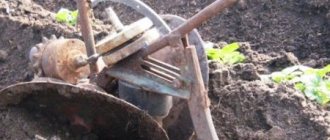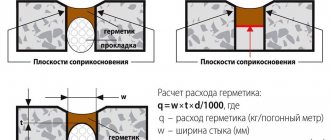Carrot seeder - an overview of ready-made and home-made devices
Not a single garden can do without healthy carrots. If a person has a garden, then he tries to grow his own products in it.
This is correct, because only by planting crops with our own hands can we be sure of their quality and usefulness. The work of a summer resident cannot be called simple; during the season you need to do a lot of different things, without which you cannot get a harvest. To make your work easier, you can use different devices - a carrot seeder is a good example of this. You can buy it in a store, or make it yourself, there are many options and let’s get to know them. This is interesting!
Nowadays, there are more than 60 varieties of orange root vegetables; its homeland is the original Afghanistan. Europeans learned about carrots around the 10th century.
How to sow seeds
If you plant flowering plants yourself as a source of pollen for your bees, you will need a seeder. It can significantly facilitate your economic activities in the territory of your apiary.
The fact is that an apiary is far from just a hive with bees. These honey insects must have a good source of food for themselves.
It’s good if a variety of flowering plants grow naturally around your site. Then you will not have to take additional measures to provide food for your charges.
If this is not the case, then you will have to plant flowering plants near your hives. When they grow up, the bees can fly around to collect useful and healing pollen.
And this pollen will be used to create beekeeping products, including honey and beebread. And the owner of the apiary farm, in turn, will enjoy the rich harvests obtained on his small farm.
By rotating a special bushing, the process of sowing seeds of flowering plants occurs. You can use several different types of bushings in one device in order to plant different types of crops on your site.
In addition, do not forget about the ability to adjust the special brush. With its help, you can control the intensity of the release of seeds of flowering plants into the soil.
In addition to the finished product, you can purchase additional parts and spare parts for your device in specialized stores. The main consumables are rotating bushings.
Read also: Alloy containing copper and 10 50 zinc
The fact is that each crop requires its own bushing. It helps to comply with the sowing norms of a particular crop during agricultural work.
Thus, if you have a large apiary farm, then most likely you will want to plant several different crops on its territory. And for this you will have to stock up on a whole collection of different bushings.
Store options for seeders
Syringe
A fairly simple and accessible device for everyone. As you can see in the photo, the syringe has a transparent cylinder where carrot seeds are placed, and a rod that pushes them through a special hole in the base. This device is sold in gardening stores and hardware stores. Convenient, simple. The price, depending on the region, is about 100-150 rubles.
The second option, which has long won respect among summer residents, is a seeder for sowing carrots, which is shown in the photo below. The principle is the same as that of a syringe - the seeds are placed in a barrel, and then pressed into rows in the garden using a rod and a spring. Very budget-friendly - up to 100 rubles and a simple option. But these two planters are suitable for small areas that can be planted by hand without much difficulty. But if you need to sow a large area in the garden, then you will have to purchase more serious units, more on them later.
Roller seeder
Convenient, technically simple device. Our country produces videos as well as foreign analogues. The price of the Russian unit is 200-250 rubles. You can buy such a device in garden stores and online stores. The principle of operation is elementary - the round body opens, the seeds are poured in, the lid closes. After that, the handle-handle is inserted and sowing is done in the rows that were made in advance.
The big advantage of such a roller is that you don’t need to bend over, as is the case with the first two devices, because you can even make a handle with your own hands and to suit the required height. The roller makes it possible to easily sow a large garden, but if you have an impressive area, then the units described below are suitable for you. But it is worth noting that we will be talking about seeders for small-family crops, which are suitable specifically for manual work in the garden, and not about complex machines with many attachments for fields like walk-behind tractors.
On a note! Another advantage of this roller seeder is that it is suitable for sowing not only carrots, but also other vegetables, herbs and even peas.
Precision seeder
Such devices are perfect for carrots, beets, peas and other crops. Yes, they already cost an order of magnitude more, but they also make the work much easier. Again, such units can have a complex design, a simple one, differ in size, functionality, or be from our manufacturers or foreign ones. This affects the cost. See below for examples of commonly used seeders and their photos.
Precision seeding units:
- SOR-1/1. Seeder from , single-row. It can have a different design - either sowing using a brush mechanism, or using a sleeve mechanism. Quite an inexpensive option - up to 3 thousand rubles. The grain basket holds quite a lot of seeds. It can sow different crops, for which the bushings that come with the kit are changed;
- 1001-B. This seeder is already from, which is located in America. The option is compact, light - up to 4 kg, can plant different crops and medicinal herbs, sowing depth is adjusted. The set includes six discs that can be changed and make it possible to plant 28 crops, including vegetables and herbs. The price of the unit is more expensive - up to 7-8 thousand;
- Seeder SMK-1. Again from, a good unit that you can simply attach to the cutting and then control it. Price – up to 1000 rubles. The mechanism has brushes and a shaft, sowing is carried out in one row. If your area is large, then you can purchase another modification - the SMK-5 seeder is five-row, sows crops to a width of 6 cm, SMK-2 is a two-row. The width can be adjusted from 6 to 24 cm. Pour the seeds into the container and sow, everything is quite simple, but at the same time effective;
- AL-KO US 45. A very good option for a precision seeder for both carrots and other crops and for spreading fertilizers. It costs no more than 2 thousand rubles, you can order it on the Internet. A German unit, convenient in that it has a 22-liter tank, where you can pour a lot of seeds and fertilizers, as well as a handle that is easy to hold with two hands.
Of course, there are very, very many seeders, each company has its own, but the principle of operation is largely similar, the efficiency is the same, only the cost can differ many times. If you have a large or small garden next to a private house or in a country house, then these seeders are perfect, they won’t take up much space and won’t require special skills. Well, we’re moving on to the second part, and these will be life hacks on how to make simple devices for sowing small-seeded crops with your own hands and at no cost.
On a note! Nowadays, there is a special adhesive tape on sale, on which the seeds are already applied at the required distance. It just needs to be buried in rows, sprinkled with soil and watered, as with regular sowing.
Lawn seeder: best models and manufacturing recommendations
- View the full image
Lawn seeder
Lawn seeder - what is it, what is its purpose?
Rules for using the device
Manual and mechanical seeder - what is the difference, which is better?
Review of the best lawn seeders models
How to make the unit yourself?
Not only the owners of large suburban areas, but also summer residents with a small plot for a vegetable garden think about the design of their plot. The backdrop for cozy gazebos, luxurious flower beds, and rockeries will be a green lawn with thick silky grass. But you need to place the grass on the lawn tightly in the form of a continuous carpet. And this process is difficult to carry out manually. This is why lawn seeders come in handy. Any type of green lawn in front of the house will decorate the area, because children can play on it and adults can relax after work. It is best to plant a green lawn in the sun by sowing it with a mixture of specially selected grasses. But first, the area is dug up, leveled, and rolled. After a month and a half, the lawn is sown with grasses. To facilitate the procedure, you will need a special seeder.
DIY carrot seeders
Plastic bottle
This is the most common garden device for sowing small seeds. Take a 1.5 liter bottle, unscrew the cap, make a hole. This can be done using a screwdriver. We insert a juice tube here and secure it at the base with thread or tape. Mix the seeds with sand so that they do not fall thickly and at the same time there is drainage. We sow in rows and water.
Paste and bottle
This is the second version of a manual seeder for carrots, which you can do with your own hands and, again, from a bottle. We also make a hole in the lid, but without a tube. Cook a sticky mass from a liter of water and a spoon of flour. Pour the seeds here and mix them thoroughly. Pour into a bottle and plant. The nutrient mass will distribute the seeds so that minimal picking is needed.
Alternative fixture options
A carrot seeder can be made from almost any material. So, the available varieties of this device are the following.
Plastic bottle
Containers of any size are suitable for these purposes. You need to make a hole in the lid to install a cocktail straw in it. Secure it with tape for safety. When sowing, shake the bottle with carrot seeds. Unlike tape, you will still have to remove weak sprouts, but in small quantities.
Pill box
The carrot seeder is made from a box with a dispenser that used to contain medicine, sweetener or baby jelly beans. Thanks to the presence of a button, the seeds are separated. But first they need to be mixed with sand. Such a device will be an indispensable assistant in a small garden.
Homemade manual seeder: nuances of accurate and simple sowing
Every summer resident and gardener knows how important it is to plant vegetables correctly. This process is labor-intensive, quite expensive in both time and money. After all, it is necessary not only to evenly distribute the planting seeds in the furrows, but also to further thin out the seedlings manually, forming crops. A special seeder will help to significantly simplify the work, which, even in manual mode, will be a real help in planting. The article will discuss the nuances of the operation of planting structures, the principle of manual assembly of the simplest mechanisms, the features of operation and the creation of manual machines for more accurate seeding.
Planting beets: secrets and subtleties of success
A good harvest begins with planting. This axiom applies to all garden plants, including the popular and widespread table beet. Growing it is a pleasure: it is unpretentious, ripens well in open ground not only in the southern regions, but also in the middle zone, and even Siberia. If you properly prepare the soil for cultivation, plant the crop after good predecessors and at the optimal time, and use the most suitable sowing methods, then the harvest of this overseas beauty is guaranteed to be plentiful, tasty and healthy.
Tool requirements
A completely working structure is made from available materials: various recyclable materials, tin cans, plastic bottles.
It is advisable to use more complex structures made of metal sheets only for industrial-scale cultivation of vegetable crops. A good example of the simplest design for planting is a carrot seeder.
Certain aspects apply to self-made mechanisms for planting vegetables.:
- The placement of seed into the soil must be in a certain quantity (per 1 linear meter) and to the required depth.
- Seeds should be distributed evenly, without gaps and without damage.
- The mechanism ensures straightness of planting rows and row spacing.
- After each laying, the grooves should be filled with loose soil.
Sowing small seeds is best done using mini-seeders. Such devices are suitable for growing carrots, onion sets, salad greens, that is, those crops that have rather small planting material.
How to create your own design
Do-it-yourself lawn seeder is easy. Any home craftsman can create such a unit if he has the necessary working tools and available materials. To make such a simple design, you do not need to purchase expensive spare parts. To create a lawn with your own hands, you need to build several gutters through which the seed material will move to the surface of the earth. It is very easy to build a seed tank. To create a lawn seeder with your own hands from available materials, it is important to have the desire to work and skillful hands. Sowing units created by home craftsmen are very popular.
A lawn seeder is an indispensable assistant for the owner of a plot of land, which will significantly save grass seeds and make work easier.
You will need much less time to create luxurious green grass with a lawn seeder and properly fertilize it. Creating a wonderful lawn with your own hands is easy!
Features of application
The basic principle of operation of the simplest sowing mechanism is to limit the spilling of seeds out.
An open box with a double good bottom is used for this procedure. A movable plate is inserted into the formed space. Grains or seeds are poured into the bottom of the box (upper) with holes slightly larger than the size of the planting material; in the lower tier of the mechanism there are larger holes, they coincide with the top. When pushing in the middle intermediate plate, the holes in the bottoms do not communicate, which means the grains do not spill out. If the valve is moved, the sower will start working again. To avoid thickening of the crops, you should not pour a large number of seeds into the structure at once, rolling them over the mechanism.
Many vegetable growers equip the movable (middle) plate with a spring, which facilitates the operational process.
Using the landing mechanism is very simple. A furrow is marked in the garden bed. They place a homemade seeder on it and move the device forward. The tank begins to rotate - grain or seeds are poured out evenly. Then, using an improvised hoe, the plantings are covered with loose soil.
The seeds are fixed in the seeder using a transparent plastic tank. The entire structure can be easily converted for any vegetable crop; for example, in a radish seeder, the holes in the tank need to be made smaller than in a mechanism for planting corn. It is very easy to make improvised parts using simple materials. For economical and high-quality planting of different vegetable crops, it is necessary to make about 3-4 tanks with holes of different sizes for the seeder.
Basic rules of use
One of the main advantages of a homemade seeder is its ease of operation. Even a novice farmer can handle its management:
- Before starting sowing activities, it is recommended to thoroughly prepare the soil, loosen or dig it, and moisten it.
- Next, using a hoe, you need to make furrows of the same length in the garden bed.
- A hand seeder should be inserted into the furrows and walked along the rows. During movement, seeds will evenly pour out of the container and be distributed throughout the area.
- If you have a steel hoe plate that covers the sown seed material with soil, you won’t have to go through the area twice.
- If you want to sow larger or smaller seeds, you just need to change the tank to a new one, with holes suitable for a certain size of seed material.
A carrot planter will allow every summer resident to do spring sowing work quickly and with pleasure. The described unit has a simple design, easy to control and operate. And by following simple recommendations, you can make a practical and effective unit with your own hands, without spending a lot of time and money.
DIY making
By using a mechanism for planting small seeds, sowing can be accelerated 10 times. As an example of a simple hand-held device, consider a carrot seeder.
To make it you will need the following materials::
- Plastic or metal shaft. You can use a part from a thick-walled pipe.
- A wheel made from a tin can (a small bicycle wheel will do).
- A bunker made from a plastic bottle, container, or shampoo container.
- Retaining rings designed for the wheel.
- Foam rubber.
- Transport bracket (1 piece).
- Wooden handle.
- Screw “M 4” (from 4 to 8 pcs.).
- Restrictive rings/clamps (from 2 to 4 pcs.).
- Nut “M 4” (from 4 to 8 pcs.).
For high-quality assembly you will need tools: a screwdriver, drills with different diameters, scissors, a drill, a knife.
The process of manufacturing a simple manual seeder takes place in several stages:
- The shaft is being prepared. In the middle of the plastic pipe, recesses of different diameters are drilled (for large and small seeds). The pipe is not drilled through.
- Wheels are made from tin cans. To ensure better grip, rubber rings are placed on the wheels in several rows. In the middle, using scissors, a hole is cut equal to the diameter of the shaft.
- A hopper is cut out of a plastic container. The lower part is cut off, holes are made on the opposite walls for the sowing shaft. The bottle is placed upside down.
- The hopper is placed on the shaft. Foam rubber is laid and glued to the bottle walls so that during further rotation the excess seeds are removed. That is, when the foam brush is turned, the shaft should produce small cells, each of which will contain one or two seeds.
- The transport bracket is attached to the shaft with wheels and secured with screws.
- The hopper is carefully attached through a metal plate to the bracket. When the shaft rotates, it should not move.
- A wooden handle is installed.
The simple design will significantly reduce labor costs . This is how you make a manual seeder with your own hands. The main disadvantage of this mechanism is the limited sowing (only in 1 row) and the sowing of only one vegetable crop due to the different size of the seeds. The problem can be solved by using several replacement cans with different holes.
Much more complicated is a self-made sowing device, with which you can work with seeds of different crops. The main working mechanism in the universal design is the sowing shaft, which is an aluminum tube with a diameter of 30 mm. Holes are drilled in three rows of different sizes. Each line is made for one crop.
Manual
This device works and moves with the help of human efforts:
- The wheel, on which special blades are located, creates grooves of a certain depth when moving.
- There is a spout coming from the bunker. The specified volume of seeds is poured through it. Their supply is regulated by a valve.
- The rear wheel has a smooth surface. It fills up the holes.
A manual seeder is suitable not only for planting carrots, but also for other small seeds. Typically used in summer cottages and greenhouses.
Pros of handheld devices:
- low cost;
- compactness;
- You can plant different seeds.
Minuses:
- suitable for small volumes of work;
- no automatic fertilizer addition.
Hand planters can also vary. There are: piston, funnel-shaped, bar and mini rakes.
The video shows a model of a manual seeder for greenhouses:
Piston
The device is a cylindrical plastic container. On top there is a piston with a spring. Seeds are poured inside. There is a conical hole at the bottom of the device, it can be adjusted. Through it, seeds fall into the soil. The seeder squeezes a certain amount into pre-prepared holes. The device is placed at a height of 5 cm above the ground.
Advantages of the device:
- relatively fast landing speed;
- low price.
The disadvantages include:
- uneven supply of seeds;
- indistinct groove;
- the need to thin out the sprouts.
Funnel-shaped
The mechanism is a funnel. The volume of the hole can be adjusted by the diaphragm installed inside. The funnel is installed at a height of 15 cm from the ground. The device is easily shaken and the seeds are poured into the groove.
Advantages of the device:
- possibility of self-production;
- low cost.
Minuses:
- uneven grooves;
- difficult to regulate.
From a block
Made from bottle caps and wooden blocks. It is necessary to loosen the soil well in advance. The lids are used to press out holes in the ground for sowing. The seeds are placed by hand.
Pros:
- low cost;
- possibility of self-production.
Minuses:
- low seeding volume required;
- manual landing;
- a lot of time is wasted.
Mini rake
Consists of a long board, a handle, and small planks. The teeth are cut out on the underside. This part of the rake is fixed perpendicular to the handle, which acts as a handle.
Pros:
- low cost;
- possibility of self-production.
Minuses:
- small volume of sowing;
- the soil must be prepared in advance.
Precision seeding mechanism
An important task of using seeding structures is to ensure uniform planting . To plant seeds in the ground at a strictly defined distance, manual precision seeding drills are used; these mechanisms are easy to make with your own hands, just like the simplest devices described above.
Design
The device consists of one or more containers with seeds, a frame on wheels, and a control handle.
To independently manufacture such a unit, you will need a turning tool or a drill to drill metal sheets, the thickness of which is approximately 1 or 2 mm, and the diameter is about 5-8 mm. When planning a connection between a seeder and a walk-behind tractor, it is better to use rigid bolts that are more vibration-resistant instead of rivets . The front wheels are designed to form furrows in the beds, where the seeds fall from the hopper. Using the rear wheels, the resulting holes are filled with loose soil.
Additional types of seeders
There are many methods for planting seeds. Carrot seedlings present the greatest difficulty for gardeners. They are quite small and difficult to plant evenly. After germination, a very large number of young shoots have to be removed. Therefore, it is recommended to use different methods for planting:
- Sowing with toilet paper - numerous seeds are glued to a piece of toilet paper in a random or strictly defined order. Later this area is covered with a small layer of earth. When the sprouts sprout, they do not need to be discharged. The only thing is that weeds sprout abundantly among them. The disadvantage of this method is the long-term gluing of small seedlings onto a piece of paper;
- A seeder from an egg container is an original and simple way. The advantages of this method are its simplicity and evenly planted seeds at the required distance. To do this, you need to press the tray into the ground and pour 1 or 2 seeds of planting material into the resulting holes;
- Using tape - in specialized stores you can find a special tape for planting carrots. The seedlings are already glued to it in the required order and at the optimal distance. Planting is easy - tape is applied to the furrow made and sprinkled with earth.
Read also: Attachments for glass engraver
Thus, it is easy to plant carrots without a seeder at home, but before doing this you need to either spend money or be patient by placing small seeds on toilet paper. But to get a rich, and most importantly, even harvest, you can make any sacrifices.
Range of modern seeders
If making a planting unit yourself causes difficulties, it is recommended to immediately purchase ready-made structures.
The assortment on the market is quite large. The American model of precision seeding “1001 - B” is equipped with 6 replaceable discs. With such a seeder you can plant 28 types of vegetable crops. Using the adjusting screw, you can change the planting depth. Newtechagro seeders are single-row types. Designed for sowing beets, carrots, onions, and cabbage . But such designs are expensive.
But there are also cheaper analogues - precision seeders "SOR - 1/1". They are also single-row, can be equipped with a bush or brush sowing unit, the row marker is 0.5 m. This is quite enough for an average garden.
Using a manual seeder can significantly reduce labor costs, increases the speed of the planting process, simplifies the technology, significantly improves the quality of crops, and hence excellent harvests in the future.
About the design of a seeder for manual precision sowing of seeds
A manual precision seed drill, just like a garlic seeder, in its design features looks like a rather unpretentious invention . It consists of one or more containers where the seed will be located, a control handle and a frame located on wheels.
The wheels, which are located in front of the device, form holes or furrows, after which the seed from the hopper falls there, and the rear wheels fill the resulting hole with loose soil.
As we can see, the principle of operation is quite simple. In fact, you simply direct the unit over the area where you plan to grow various vegetable crops, and behind you there will already be holes with seeds.
At the same time, with the help of a manual seeder and a lawn seeder, you can plant not only seeds of lawn grass and vegetables, but also fill sand or fine gravel on icy and snowy paths in winter, so that you can safely walk on them without fear of falling.
In general, the process of working with a manual precision seeder can be divided into three stages:
- Assembly process. First you need to install the control handle from the transport position to the working position, and then put the rear wheel on the axle (if the unit used consists of two wheels). If necessary, we adjust the marker.
- Carrying out regulatory actions. Depending on what kind of crop the seed will be used, the installation of a specific disc in the bunker will depend. It is difficult to confuse them because they are all properly labeled.
- The depth of the share must also be adjusted according to the specific seed.
- Carrying out sowing work. After we put the unit into action, torque is transmitted from its front wheel to the disk through a belt or chain drive. This disk captures the seed from the container, and the ploughshare forms the desired depth of the hole.
- The marker is responsible for ensuring that the row of seeds planted is level , so he forms a line on the ground for the next row.
For convenience, as well as for uniform distribution of seeds in the soil, it is recommended to sow the first row along predetermined contours. You can drive two pegs along the edges, connecting them with rope or thread. Thus, following parallel to this border, you will get a very even and visually beautiful row.
Professional units for sowing seeds
They are attached to a powerful tractor and are used to create high-quality turf in stadiums and golf clubs. Up to 100 kg of seeds can be loaded into the hopper of this lawn seeder. Such units are characterized by ease of operation and high performance. Manually adjustable and creates a sowing depth of 0.5 to 2.5 cm. To make a golf course beautiful, you need several varieties of grass.
The Shindaiwa RS 76S professional spreader has large pneumatic wheels, a powerful frost-resistant hopper body with impact-resistant properties. The hopper capacity is 30 l. The spreader frame is made of stainless steel. The width of uniform processing is 4 m.
Models, technical specifications and prices - which one is better to buy
Manual precision seeders are designed to speed up the sowing process. Therefore, few people question the feasibility of purchasing them. However, to make the right choice, you need to pay attention to several main points:
- The cost of the unit, which can vary greatly among different manufacturers.
- The total number of containers for seed material. Again, the more data bins, the higher the cost of the device.
- The depth of the holes being formed will depend on the crop whose seeds are planted.
- The weight of the device also plays a role, especially when working over large areas
- The presence in the unit of additional devices that make the sowing process more convenient (marker, plow for filling seed, etc.).
What is a carrot planter
A seed seeder is a special mechanical device, which, due to its design features, makes it possible to quickly and efficiently sow seed along a given trajectory.
The operating principle of such a device is quite simple:
- blades or special spikes are installed on the front part of the unit, with the help of which furrows of the required size will be formed;
- Along the width of the seeder, at a certain distance from each other, containers for seed material are installed;
- a hole is made at the bottom of such containers through which the required amount of seeds falls out, that is, into the soil;
- a smooth wheel attached to the unit fills the furrows and levels the soil.
- The vegetable seeder has a number of undeniable advantages, which include:
- acceleration of the process of sowing seed material;
- rational consumption of seeds;
- precision seeding, which makes it possible to simplify the care of seedlings in the future;
- simplicity and ease of use;
- no need to thin out seedlings.
Using the described device, it is possible to process a large area in a short period of time.
How to make a homemade seeder with your own hands
made quite simply with your own hands but before starting work you need to make sure that you have everything you need. In particular, you will need a seed container, which should be made of plastic.
Here you can get acquainted with the work of the Viking cultivator.
Kamaz running on methane means high productivity and great savings.
The boat cart has become very popular among Russian fishermen.
This is explained by the fact that plastic products are transparent, which allows you to control the amount of seed. In addition, we will need the following components:
- a bolt that acts as an axis. The container with seeds will rotate on it during operation of the device;
- We will also need a plastic pipe, the length of which should be identical to the depth of the plastic bin container. In addition to the plastic one, we will also need a steel pipe, its length should be the same;
- to secure the hopper we will need washers, as well as aluminum wire.
Let's move on to the assembly process. We will describe it in the format of step-by-step instructions so that an approximate algorithm of sequential actions can be seen:
- of the plastic jar that serves as the future bunker needs to be determined. A through hole must be drilled at the marked point. We remove the cover, after which we make another through-type hole in the side, but this one is rectangular in shape;
- The hopper will be filled with seed through this hole.
- We place a plastic pipe in the center of the plastic jar, which will protect against material spilling out of the hopper. Then you need to install a steel pipe into this pipe and screw a bolt inside it. Then we tighten the bolt with a nut, which will allow our structure to rotate freely;
- On the side of the plastic container we mark points for future holes. The distance between them should be approximately 30 mm. We heat the nail, and then make holes in the marked places (the diameter of the nail must be chosen so that the seeds pass into the holes made by it);
- Then you can move on to making the handle. You can take a regular shovel handle, then attach it to the seeder. It is fastened with a regular bolt and nut, so you need to first drill a through hole at the end of the handle into which the bolt is placed;
- In order for the sowing process to be more automated, it is necessary to provide a device that would fill the holes with seeds. An ordinary sheet of iron will do, but it needs to be bent a little so that it rakes the earth better;
- We attach our workpiece to the handle so that it is higher than the container with the seed.
In principle, our homemade device is ready, i.e. you can begin full-fledged sowing work. Naturally, this device diagram is quite simplified, but it copes with its main responsibility.
The main point of all homemade products is to save money, so there is no point in complicating the design with additional devices.
By the way, before starting sowing work, it is necessary to carry out preliminary preparation of the surface where the work will be carried out. It involves removing excess debris from the area, as well as loosening particularly hard areas of soil.
It won’t hurt to water the soil with enough water. If you have not included a device in your homemade seeder that scoops up the holes with seeds, then you need to prepare several buckets of soil to fill our seeds.
